 Today in Tech
Today in TechBest fitness gadgets that give top results
High-tech fitness gadgets are finally catching up with our real lives. They can now track, motivate, inform, inspire, entertain — even help us look better in a bikini. But just like the clothes we wear, fitness gadgets are not one size fits all.
The electronic armband that helped my friend Jennifer shed 145 pounds on last season's The Biggest Loser isn't the right fit for my BFF (best fitness friend) Tom, who is a competitive 50-something triathlete. And the perfect gadgets for them are still different than those that've worked for me, a fairly active, formerly athletic 40-something mom, doing all I can on the go to keep my weight down as my workload, stress level, and age just keep going up. Funny how life works out that way.

Before you spend any more time, energy, or money on a high-tech weight loss or fitness tool that promises miracles and delivers squat, here's how to make sure you get the right device for your specific goals. (I'm not going to cover fitness apps in this column, but I will soon.)
Measurement Devices: Help losing weight and starting from scratch
Calling all couch potatoes! You want to lose weight, you need to lose weight, but you just... can't. Help is finally here in the shape of an assortment of lifestyle monitoring and measurement devices. Obviously, there's no replacement for eating better and exercising more, but if it were that easy to know what diet and health decisions to make and then actually make them, we would all look Halle Berry or Brad Pitt.
Still, these gadgets really do work. They range in price from $100 to $300 and come in an array of shapes, sizes, and levels of commitment and tracking. There's an armband you wear all the time, a smart bathroom scale that transmits data to a smartphone or laptop, a tiny movement tracker clip that you put on your belt, even a Band-Aid-like patch (launching later this year) that transmits 500 data readings on your overall health. The idea behind these gadgets is that you can't improve what you can't measure, so each one takes various readings related to your health and fitness, gives you an easy dashboard view of it all, and makes recommendations based on your goals. Here's what I've tried out so far.
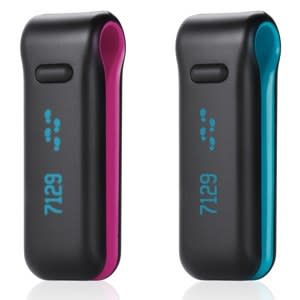
1. Fitbit Ultra
Cost: $100
Clip this tiny tracker (about the length of a car key) onto your waistband or pocket. Then as you go about your day (or night), it monitors your steps, distance, sleep patterns, and even stairs climbed. It logs all of the activities you perform in one day, and when you hook it up to your computer, you can see how that data translates into an overall picture of your health (or lack thereof). If you log your calories, you can actually see why you're not losing weight, since it's pretty obvious when you're eating more than you're burning. What's great about it is how small and simple it is to use.
Best for: Someone who likes to keep things simple — both as far as tracking and the level of tech savviness it takes to use it. And you don't need an iPhone to use this. I gave one to my mom, whose activity level I would put at pretty outdoorsy for a 60-something. She cross-country skis and take walks, and she can even (through some encouragement from me) attach a USB cable to her computer. She loves that the little flower display in the Fitbit that grows as she reaches her exercise goals for the day. This device is not great, however, for runners or athletes.
Drawbacks: The only thing I don't like is how many times I've almost flushed it down the toilet. That's right — buyer beware, if you clip it on your jeans or even pajama waistband, know that the little sucker can fly off when you sit down. I'm just sayin'.
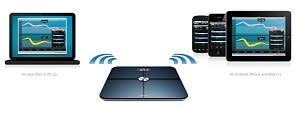
2.
Withings WiFi-Connected Body Scale
Cost: $160
I cannot even begin to count how many times I've totally pigged out to the mantra, "I'll start my diet on Monday." The Withings scale will help you get out of that rut by tracking your weight, body mass index (BMI), and total body fat in pounds. It then sends that data wirelessly to your computer, phone, or tablet. It shows a bar graph of where you are at any given point, and the website (like many others) gives you a lot of great news and advice. You can share the data with your doctor, a coach, or even with your social media support system via Twitter or Facebook. Yikes!
Best for: Tech-savvy people and families, since it tracks up to eight people total. The scale syncs wirelessly to your phone, so this is a great tool for people who actually have a smartphone and know how to use it. It's easy for someone who's a little tech-savvy to use, though wireless syncing is rarely easy, especially if you live in an old house like I do. It's also great for people who are okay with tweeting what they weigh, as that sort of accountability, while absolutely terrifying for some (me), is proving to be a great motivator for many others. So far, the Withings scale has helped me to understand what weight gain is just related to PMS or monster burrito bloat, and it's been a great tool for staying on track with healthy eating and exercise overall. It's also nice to see how much my overall body fat is decreasing with regular exercise, even when my weight stays the same.
Drawbacks: There's always a question about the accuracy of body fat measurement devices that sent a tiny current through your body to calculate the percentage of water versus muscle, fat, and everything else that makes up our human anatomy. While this seems as accurate as many other medical measurements I've undergone, that question of accuracy still remains. Other than that, the price is the only other drawback. It's a lot to spend on a scale. But this is no ordinary scale.
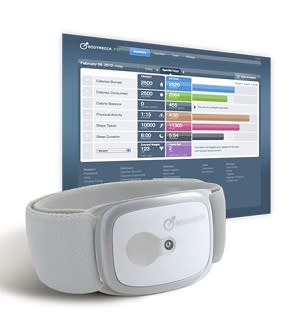
3. My Pick:
BodyMedia Fit Link Armband
Cost: $200 + $6.95 subscription fee (first three months free)
The most comprehensive of these lifestyle tracking gadgets, for me, was the new BodyMedia Fit Link armband. You wear it around your upper arm, and it tracks calories in and calories out, monitors your sleep and how much you exercise, and takes some 5,000+ readings about your body every minute of every day. Of everything I've tested, this clearly does the most and presents all the data all the most easy-to-understand dashboard on your smartphone, tablet, or computer. According to the company, in a control group study, people who used it lost 3 times more weight than people without the device. I loved it because I finally know exactly what I have to do to lose weight or break through a fitness plateau, and this little gadget keeps me connected with my goals at all times.
Best For: People who are serious about making a lasting change in their health and fitness. This device requires a level of commitment to log the food you eat and wear the armband all the time. It requires you to be mildly tech-savvy, again, at least enough to sync it with your computer, tablet, or smartphone. It's also the most expensive of the devices, so when you fork over money for this gadget, you should be serious about making it work for you — because it can and will work for you.
Drawbacks: I hate wearing the armband on my upper arm — not dislike, hate. It creates a weird lump under my blazers and wrap dresses, and I'm embarrassed to wear it with short sleeves. If it sounds like I'm whining, I sort of am. Since I mostly work from home, the lumps aren't that bad. The cost is the other drawback. But when I think about all those years of gym memberships I never used... again, it's not so bad.
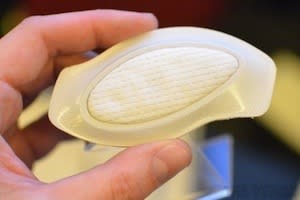
4. The BodyMedia patch
BodyMedia is also coming out with a seven-day patch version of its health tracker later this year. It will let people take this kind of gadget for a test drive before making a bigger commitment to buy in for good. The company expects it will appeal to healthcare providers looking for activity snapshots of their patients. I'm excited for the Patch to launch and will continue to track its progress. BodyMedia's CEO told me it's expected to retail for around $30.
Motivational Gadgets: An extra push for workouts
You already run. Or ride. Or swim. Maybe you do all three like Tom, my amazing triathlete friend. Maybe you even pump some iron on your off days and actually like it. The point is, you're not exercise-averse — you just need a little blast of inspiration keep at it. Or you're totally driven, detail-oriented, and generally obsessed with metrics. However you get to this point, if better physical fitness is your ultimate goal and you want something that records and analyzes data such as distance, speed, and heart rate to give you that extra push like a personal trainer screaming at you might, here are some of the new gadgets that get you totally pumped.
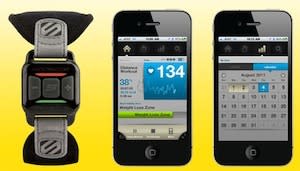
1. Scoshe myTrek Wireless Pulse Monitor
Cost: $100
If you have an iPhone or iPod touch, then this Scosche myTrek Wireless Pulse Monitor is a great addition for managing your target heart rate without a chest strap. It also keeps track of training type and calories burned, plays music, and provides inspiring audio alerts through your headphones during a workout. You strap it onto your forearm, where it uses LEDs, a photo sensor, and an accelerometer to capture vitals as you work out. Basically, it uses sophisticated technology to make your life easier but hides it all in a super simple, not overly designed package.
Best For: iDevice lovers who run or ride a lot. There's a whole lot of us who work out with our constant companion, the iPhone or iPod touch. This is an affordable and multifaceted add-on for us. I listen to audiobooks on my iPhone when I run, so putting the forearm band on and hitting the road is seamless and simple for me. I really like how you can preprogram your heart rate so that when you're working out at 50% of your target heart rate zone, it tells you to speed up; at 90%, it might might tell you to slow down. This is great for anyone who's reached a fitness plateau and needs this kind of data to perform better overall.
Drawbacks: You have to own an iPhone or iPod touch to use it. You have to stay within 30-some feet of your iDevice for it to work. You need to be fairly tech-savvy to make it work well; I wouldn't give this one to my mom. The Digifit app that you use to add on other metrics is getting mixed reviews, though it's always worked fine for me.
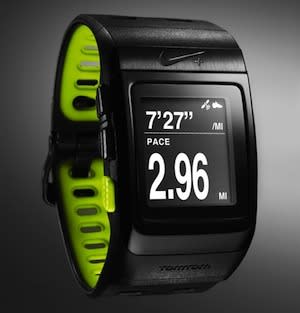
2.
The Nike+ Sportwatch GPS
Cost: $200
This isn't the newest kid on the block, but several updates make it relevant, and the one I picked up last year is still working great. It tracks your run times, distance, calories burned, and location (thanks to its built-in GPS), compiling it all for you to see in visual form on the watch and on your Nike+ page online. There's an awesome heat map that shows you where other Nike+ runners are working out right now (more people are represented in reds, while smaller crowds are represented in yellow), so you can join in or run the other way. This is perfect for travel, since you can see where all the popular running spots are in new cities.
Best For: Runners, especially indoor treadmill runners or people who run in easy-to-find GPS areas. It requires you to be moderately tech-savvy to use it. You get a lot more out of it when you use the website daily as well. It provides great encouragement and inspiration when training for a specific event like a 10K or marathon.
Drawbacks: The biggest drawback for me has been having to use the website daily to get the most out of it. I need a set-it-and-forget-it device. If I had more time, I would love the online social aspect of it, finding other runners and connecting with events. But as is, I don't use it as much as the next device on this list.

3. My Pick:
Motorola MotoACTV
Cost: 8GB $250, 16GB $300
This device is a combination GPS tracker, body tracking device, and MP3 player all rolled into one gadget that you wear like a watch. It gives you detailed reports of your workouts, keeping track of and recording data like time, distance, speed, calories burned, and heart rate. It stores your music — and the really cool part is that it keeps track of what songs make you work out the hardest, then builds your ultimate high-performance playlist. If you have a Motorola Android smartphone, you just download a free app to receive calls and texts to your Motoactv device. It's a totally great motivator — one of the best overall devices for athletes and the fitness inclined that I've tried out first hand.
Best For: More serious athletes and people who are at least moderately tech-savvy. My audiobooks don't work as well on here as music, since it's hard to build an ultimate playlist around a particular chapter onThe Art of Fielding or Born To Run. This device also has one of the most comprehensive websites to help with training, targets, and goals. This is the closest gadget to an actual athletic personal trainer that I've ever used.
Drawbacks: The biggest drawback is cost; it's the most expensive of all the devices. I'm trying really hard to think of some other drawbacks... and there just really aren't any others. It's pretty darn great.
Mobile Gaming: Play a game, do social good
The last category of newfangled fitness gadgets I've tested is, of all things, mobile gaming. That's right — if you love playing FarmVille or whipping some Angry Bird butt, there's a new gadget to get you off the couch while you do it.
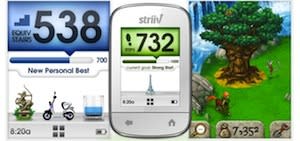
1. Striiv
Cost: $100
This little Striiv pedometer is doing something really special, motivating Americans on a level that's proven to work. It only measures how many steps you take in a day yet gets you totally addicted to being more active. How? By blending mobile gaming, similar to FarmVille and CityVille, with the push to walk more. It tracks movements like walking, taking the stairs, or running, and each activity earns, tracks, and transforms your exercise into games.
In the game MyLand, the more you move, the more your enchanted island fills with exotic wildlife and plants. You can also donate your steps walkathon-style to help save a rain forest or give a child a polio vaccine. I love this gadget. It fulfills one of the biggest challenges of fitness gadgets, engaging users over time.
Best For: People just starting out. People who love mobile games. Kids. There's a simple, entry-level amount of tech-savviness required. My mom is getting one of these, and I gave one to my 10-year-old daughter, who absolutely loves it.
Drawbacks: It's not a sophisticated device. It's not going to track calories or your heart rate. But it's a fantastically engaging gadget that opens the doors to more ways fitness gadgets can motivate, entertain, and ultimately make Americans healthier.
2. Looking forward to the Basis
Costs: $200 (available for preorder)
While it's not available to buy quite yet, I tested the Basis around CES this year and it found that indeed, it could be a game-changer. This cool-looking digital wristwatch packs a powerful fitness gadget punch. It tracks blood flow, motion, temperature, sweat levels, heart rates, and blood oxygen levels. You get the dashboard online analysis. You can earn badges, link up with friends, and compete social-network-style with leaderboards. On paper, it looks like this one gadget will be the best of all of the categories, measurement, motivation, and mobile gaming.
If only a fitness gadget could...
Some of the things no fitness gadget can do (yet) are smacking the cupcake out of my hand while it's on the way to my mouth, letting me simply tell it what I've eaten versus making me log it manually online, and allowing me to take a digital picture of my meal to analyze my daily caloric data.
All in all, these gadgets are no replacements for eating better and exercising more, but they're a good start. When used right over time, they yield amazing results. I've lost about 10 pounds and kept it off just by taking advantage of the work these gadgets do, providing data about things I can change. Making those changes has still been up to me.
What would your wish be for a fitness gadget — "If only there were a fitness gadget that..."? What do you think would finally do the trick for you, when it comes to modern technology and being healthier? Be sure to tell us here in the comments section below.
This article was written by Jennifer Jolly and originally appeared on Tecca
More from Tecca:

